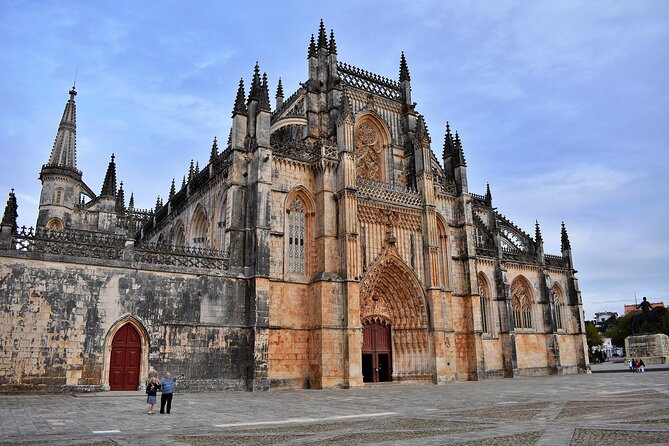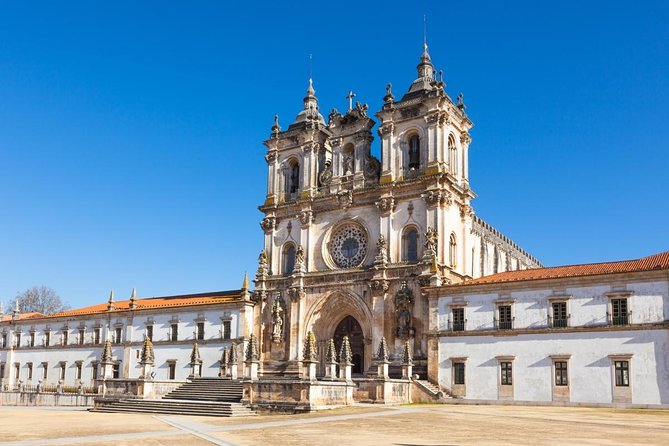As one embarks on a journey to discover the wonders of Fátima, Batalha Monastery, and Alcobaça Monastery, they may find themselves wondering if there is more to these destinations than meets the eye. Satirically speaking, of course, because these extraordinary places hold a depth of history and cultural significance that is simply waiting to be unveiled.
From the spiritual experiences of Fátima, to the Gothic marvel of Batalha Monastery, and the serene beauty of Alcobaça Monastery, there is a captivating tale waiting to be told.
So, prepare to be intrigued, for this exploration promises to take you on a journey like no other, where every step brings you closer to unraveling the secrets and stories that lie within these hallowed grounds.
Good To Know

- Fátima, Batalha, and Alcobaça Monasteries have significant historical and cultural importance in Portugal.
- Fátima is a pilgrimage site where the Virgin Mary appeared in 1917.
- Batalha Monastery was constructed to commemorate Portugal’s victory in the Battle of Aljubarrota.
- Alcobaça Monastery is a remarkable example of Cistercian architecture from the 12th century.
History and Significance

The history and significance of Fátima, Batalha, and Alcobaça Monasteries can be traced back centuries, making them fascinating destinations for those seeking a deeper understanding of Portugal’s cultural heritage. These monasteries hold immense importance in religious tourism and are renowned for their architectural heritage.
Fátima, in particular, is known worldwide as a pilgrimage site where the Virgin Mary is said to have appeared to three young shepherds in 1917. Today, millions of visitors flock to Fátima to pay their respects and seek spiritual guidance.
The Batalha Monastery, a UNESCO World Heritage site, is a masterpiece of Gothic architecture. It was built to commemorate Portugal’s victory in the Battle of Aljubarrota in the 14th century.
Lastly, the Alcobaça Monastery, also a UNESCO site, is a stunning example of Cistercian architecture, dating back to the 12th century.
These monasteries not only offer a glimpse into Portugal’s rich religious and architectural history but also provide a serene and contemplative atmosphere for visitors to enjoy.
Find more activities and experiences we've covered in Coimbra.
Exploring Fátima

Now, let’s embark on an immersive journey through the enchanting pilgrimage site of Fátima, where millions of visitors from around the world seek solace and spiritual enlightenment.
Fátima holds a significant place in religious traditions, as it’s believed to be the site where the Virgin Mary appeared to three young shepherds in 1917.
The Sanctuary of Our Lady of Fátima is the focal point of the pilgrimage, attracting devotees who come to pay their respects and seek blessings.
The sacred sites within Fátima include the Basilica of Our Lady of the Rosary, where the tombs of the visionaries are located, and the Chapel of the Apparitions, which marks the spot where the Virgin Mary is said to have appeared.
Exploring Fátima is a deeply moving experience, as visitors witness the devotion and faith of pilgrims from all walks of life.
Batalha Monastery: A Gothic Marvel
Nestled in the heart of Portugal, the Batalha Monastery stands as a magnificent testament to Gothic architecture and a symbol of the country’s rich history. This grand structure, with its intricate details and imposing presence, has captivated visitors for centuries.
Here are a few things that make the Batalha Monastery truly remarkable:
The soaring vaulted ceilings and delicate stained glass windows transport you back in time, showcasing the mastery of Gothic architecture.
The ornate stone carvings that adorn the exterior of the monastery depict scenes from Portuguese history and religious stories, adding a touch of grandeur to the already impressive structure.
The historical preservation of the monastery has ensured that it remains a fascinating cultural landmark, allowing visitors to step into the past and witness the architectural marvels of a bygone era.
The tranquil cloisters and beautiful gardens surrounding the monastery provide a peaceful retreat, inviting visitors to relax and reflect on the centuries-old history that unfolds within its walls.
Visiting the Batalha Monastery is an opportunity to appreciate the beauty of Gothic architecture and take in the rich heritage of Portugal.
Alcobaça Monastery: A Symbol of Cistercian Architecture
With its stunning Cistercian architecture and rich historical significance, the Alcobaça Monastery stands as a testament to Portugal’s cultural heritage. This magnificent structure, located in the town of Alcobaça, is one of the most important examples of medieval architecture in the country.
The monastery was founded in 1153 by the first Portuguese King, Afonso Henriques, and it has been a place of worship and cultural preservation ever since. Its architectural details are truly remarkable, showcasing the mastery of the Cistercian monks who designed and built it. The monastery features a beautiful rose window, intricate stone carvings, and a majestic bell tower. Inside, visitors can admire the grandeur of the church, with its soaring columns and vaulted ceilings. The Alcobaça Monastery is truly a sight to behold, offering a glimpse into the rich history and architectural brilliance of Portugal.
| Architectural Details | Cultural Preservation |
|---|---|
| Rose window | Place of worship |
| Stone carvings | Historical significance |
| Bell tower | Cistercian architecture |
| Soaring columns | Portugal’s cultural heritage |
Spiritual Experiences and Pilgrimages
Visitors to Fátima, Batalha, and Alcobaça Monasteries can embark on spiritual experiences and pilgrimages that will leave them with a profound sense of awe and reverence. These sacred sites offer a unique opportunity for religious tourism, allowing travelers to connect with their faith and enjoy the rich history and spiritual significance of these places.
Here are four experiences that await those who embark on these pilgrimages:
Witnessing the Miracle of the Sun at Fátima, where thousands of pilgrims gather to commemorate the apparitions of the Virgin Mary.
Exploring the grandeur of Batalha Monastery, a masterpiece of Gothic architecture that houses the tomb of Portugal’s legendary hero, Dom João I.
Discovering the tranquility of Alcobaça Monastery, home to the tombs of King Pedro I and his beloved Inês de Castro.
Participating in religious ceremonies and services, such as mass and prayer, to deepen one’s spiritual connection.
These pilgrimages offer a transformative experience, allowing visitors to reflect, find solace, and seek inspiration in these sacred spaces.
Cultural Delights and Local Cuisine
What culinary delights await those who embark on a journey to Fátima, Batalha, and Alcobaça Monasteries? The local cuisine in this region of Portugal is a true reflection of its rich cultural traditions. Visitors can indulge in a variety of delectable dishes that showcase the flavors and ingredients of the area.
One must-try dish is the famous Pastéis de Nata, a creamy custard tart with a flaky crust that originated in nearby Belém. Seafood lovers will rejoice in the abundance of fresh fish and shellfish, such as grilled sardines and seafood rice. Meat dishes like Cozido à Portuguesa, a hearty stew with various meats and vegetables, are also popular.
To accompany these flavorful dishes, don’t forget to sample the local wines, such as Vinho Verde and Port wine. Exploring the local cuisine is a delightful way to take in the cultural heritage of Fátima, Batalha, and Alcobaça Monasteries.
Common Questions
How Long Does the Tour of Fátima, Batalha Monastery, and Alcobaça Monastery Typically Last?
The average duration of the tour of Fátima, Batalha Monastery, and Alcobaça Monastery typically lasts around 8 hours. It is a recommended itinerary for those interested in exploring the religious and architectural wonders of these historic sites.
Are Entrance Fees to the Monasteries Included in the Tour Price?
Yes, entrance fees to the monasteries are included in the tour price. The tour typically lasts for a few hours, allowing visitors to explore the rich history and architectural beauty of Fátima, Batalha Monastery, and Alcobaça Monastery.
Is Transportation Provided Between the Different Locations?
Yes, transportation is provided between the different locations. Travelers have various transportation options to choose from, including convenient routes that make it easy to visit all the sites included in the tour.
Are There Any Restrictions or Dress Codes to Be Aware of When Visiting the Monasteries?
There are certain restrictions and dress codes to be aware of when visiting the monasteries in Portugal. These rules are in place to respect the cultural significance of these historical sites and ensure a respectful visit.
Can Children Participate in the Tour? Is There a Minimum Age Requirement?
Yes, children can participate in the tour. There is no minimum age requirement. It’s a family-friendly experience that allows children to learn about the history and architecture of the monasteries.
The Sum Up
To sum it up, Discovering Fátima is a sacred pilgrimage site that offers a profound insight into Portugal’s rich religious heritage. The awe-inspiring architecture of Batalha Monastery is another cultural landmark that captivates and inspires visitors. The tranquil serenity of Alcobaça Monastery provides a unique experience for those seeking spiritual enlightenment or simply curious travelers. These three historical and religious treasures, Fátima, Batalha Monastery, and Alcobaça Monastery, collectively offer a journey through Portugal’s remarkable past. This article promises to leave a lasting impression of the country’s cultural significance and historical importance.
More Tour Reviews in Coimbra
Looking for something different? Other Coimbra activities we've written about
- City Tour procession of candles, Fatima night
- Coimbra Adventure Discovery and Learning with a Local
- Fatima, Batalha, Alcobaça and Nazaré, full-day from Coimbra
- Aire & Candeeiros: Nature, Fossils and Forgotten Traditions
- Coimbra Medieval Castles Guided Tour
- Coimbra City Tour
- Fátima Walking Tour
- Walk Tomar with a Local : Knights, Myths, Culture & Secrets
- Tomar Cooking Class & Garden-to-Table Meal with Lake Views
- Aveiro and Coimbra private tour from Porto
- Best of Coimbra: Private Walking Tour with a Local
- Coimbra & Aveiro Experience: From Porto All-Included
